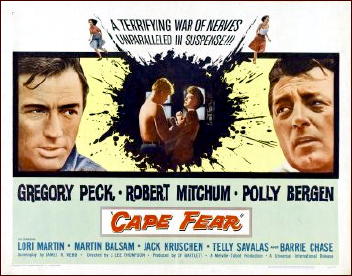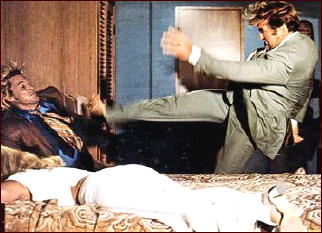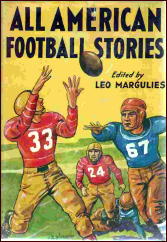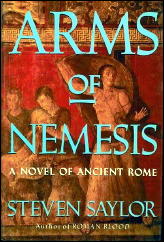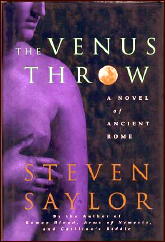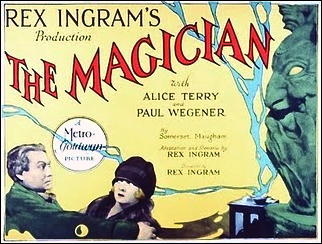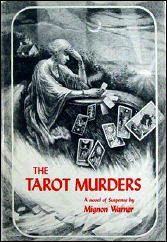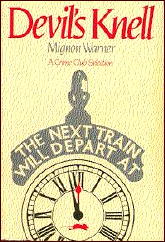August 2010
Monthly Archive
Mon 23 Aug 2010
A 1001 MIDNIGHTS Review
by Bill Pronzini:
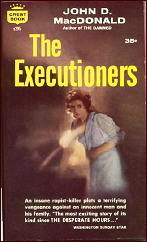
JOHN D. MacDONALD – The Executioners. Simon & Schuster, hardcover, 1958. Crest s295, reprint paperback, May 1959. Reprinted many times. Film: Universal International, 1962, as Cape Fear (with Robert Mitchum, Gregory Peck, Polly Bergen; director J. Lee Thompson). Also: Universal, 1991, as Cape Fear (with Robert De Niro, Nick Nolte, Jessica Lange; director: Martin Scorsese).
Suppose you’re a lawyer in a small Florida town, happily married, with an attractive fourteen-year-old daughter and two younger sons. Suppose some fifteen years ago you witnessed the brutal rape of a teenager and subsequently gave testimony that put the rapist, Max Cady, behind bars.
Suppose Max Cady finally gets out of prison and comes back to your town — and suppose he begins making veiled threats and following you and your family, paying special attention to your fourteen-year-old daughter, Suppose you know Cady is a dangerous psychopath, that sooner or later he intends to rape your daughter and harm you and your other loved ones.
What do you do?
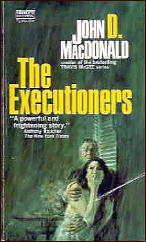
This is the dilemma that faces Sam Bowden, and this is the stuff of one of MacDonald’s finest suspense novels. The tension mounts to an almost unbearable pitch as Bowden suffers frustration after frustration and Cady moves inexorably toward explosive violence.
The climax is MacDonald at his most compelling. A must-read for anyone who enjoys expertly written, beautifully plotted suspense fiction.
Surprisingly enough, considering what Hollywood has done to quality novels in the past, the film version — Cape Fear (1962) — is every bit as tense and powerful, and features a bravura performance by Robert Mitchum; he literally radiates evil in the role of Max Cady.
Almost as good are Gregory Peck and Polly Bergen as the Bowdens. Don’t miss it when it appears on the Late Show.
———
Reprinted with permission from 1001 Midnights, edited by Bill Pronzini & Marcia Muller and published by The Battered Silicon Dispatch Box, 2007. Copyright © 1986, 2007 by the Pronzini-Muller Family Trust.
Editorial Comment: This will be John D. MacDonald week here on this blog, at least for the next couple of days. Besides the three JDM reviews posted today, coming up soon will be two more: The Good Old Stuff and The Green Ripper, by Bill Pronzini and Marcia Muller respectively; then two by David Vineyard: The Only Girl in the Game and A Deadly Shade of Gold.
Mon 23 Aug 2010
A 1001 MIDNIGHTS Review
by Marcia Muller:
JOHN D. MacDONALD – Darker than Amber. Gold Medal d1674, paperback original, 1966. J. B. Lippincott, hardcover, 1970. Reprinted many times. Film: National General, 1970 (with Rod Taylor as Travis McGee, Theodore Bikel as Meyer, and Suzy Kendall as Vangie.)
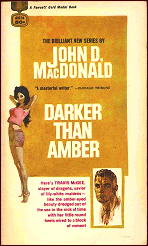
The Travis McGee series, with its color-coded titles, is one of the phenomenally popular successes of the mystery genre, and it’s easy to see why. McGee, who refers to himself as a “salvage consultant” (in actuality, he gets folks out of trouble the police can’t help them with), has many of those larger-than-life qualities contemporary readers seem to favor.
He’s big, rawboned, handsome in a rugged way. A former minor pro-football player, he now lives an enviable life-style in retirement aboard his “sybaritic” houseboat, the Busted Flush, in Fort Lauderdale. It is a retirement from which he periodically emerges whenever the cash reserves are getting low, and he’s fond of saying he likes taking it in installments rather than all at sixty-five when he won’t be able to enjoy it much anyway.
But McGee’s life is not all girls and glitter; there’s a dark, broody side of him, a part of his mind that tells him he’s capable of being a better man than he thinks he is. And he proves this, time and time again, as he fights the forces of corruption that have victimized his friends and clients.
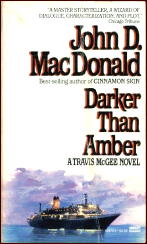
McGee is no cool professional; he takes on every case as if it were a personal crusade. And it’s there that his true charm lies: He is an emotional man who realizes he’s fallible and constantly strives to overcome it, knowing all the while that he never can.
McGee also has his irritating points, however. He is constantly editorializing, and in the later entries in the series these asides become overly long and predictable. (Eventually one says, “Oh, Travis, not again!” and skips a page.)
He also has a bad habit of indulging in therapeutic sex: A woman character has been traumatized; Travis takes her on a cruise on the Flush, makes love to her, and she is as good as new. And the women characters, while generally likable, all talk alike-a bright, sophisticated patter that makes them fairly difficult to tell apart.
Darker than Amber begins with a unique introduction to one of these women: As Travis explains it in the classic first sentence, “We were about to give up and call it a night when somebody dropped the girl off the bridge.”
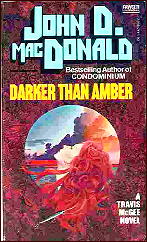
The girl, whom McGee narrowly rescues from drowning, is Vangie Bellemer, a “dead-eyed cookie” who has been working as a high-priced call girl. Unlike many of MacDonald’s women characters, she is not very pleasant, nor is she understandable until McGee’s best friend, economist Meyer, breaks through her tough shell.
What he finds is a frightened woman involved in something way over her head, something that concerns money taken from “dead ones.” Vangie’s associates have tried to kill her once, and she knows they will try again. They do — and succeed.
And Travis, feeling guilty because he didn’t prevent Vangie’s death, interested because there is money involved, and curious because of the seeming magnitude of whatever is going on, starts on his crusade. He finds other high-priced call girls, a setup involving Caribbean cruises, luxury, and death.
And when he and Meyer close in on the truth of the matter, through a series of elaborate machinations that are fun to watch, they find it is of even greater magnitude than they supposed.
Darker than Amber is among the best in this entertaining series.
———
Reprinted with permission from 1001 Midnights, edited by Bill Pronzini & Marcia Muller and published by The Battered Silicon Dispatch Box, 2007. Copyright © 1986, 2007 by the Pronzini-Muller Family Trust.
[UPDATE] Later the same day. David Vineyard’s comment about the movie made with Rod Taylor (#1), reminded me that I hadn’t included the film in the opening credits above. So I’ve added that, the photo image below, and regardless of the overall entertainment value of the rest of the movie, here’s a link to one of the greatest one-on-one fight scenes you might ever see on film.
Mon 23 Aug 2010
A 1001 MIDNIGHTS Review
by Marcia Muller:
JOHN D. MacDONALD – The Brass Cupcake. Gold Medal #124, paperback original, 1950. Reprinted many times.
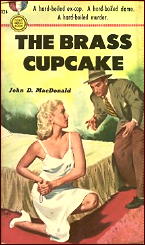
The career of John D. MacDonald has been a long and varied one, beginning with the publication of this excellent first novel. His books have ranged from modest paperback originals to the immensely popular Travis McGee series, as well as fat best sellers such as Condominium (1977) and the recent One More Sunday (1984).
Likewise, the quality of his work has varied, from the truly terrible Weep for Me (a 1951 original that MacDonald himself refuses to allow to be reprinted) and the boring small-town drama Contrary Pleasure (1954), to such outstanding novels of suspense as The Damned (1952), Murder in the Wind (1956), and The Last One Left (1967).
The recurring theme in MacDonald’s work is corruption — personal, corporate, societal-and his heroes are men and women who pit themselves against it. MacDonald draws heavily upon his knowledge of finance, land development, and Florida politics in constructing intricate plots, and his novels, particularly the later ones, are filled with editorial tirades about the abuse of the environment, corporate greed, personal greed, or whatever else happens to have been bothering him at the time of writing.
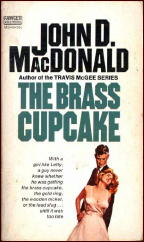
In the earlier novels, these statements of position seem a natural outgrowth of the narrators’ personalities, but in later books they become long-winded and intrusive.
In The Brass Cupcake, the evil is police corruption. The hero, Cliff Bartells, now an insurance adjuster, was once on the Florence City, Florida, force, but lost his badge for not going along with the local “arrangements” between the police and gambling establishments.
That badge — fancy and gold — is Bartells’ brass cupcake: “Anything you got by guile … was called a cupcake So when they took it away from me, it wasn’t even a badge any more. Just a cupcake. Something I chiseled and then got chiseled out of. A brass cupcake. Something of no importance.”
The murder with which the story opens — the death of a wealthy old woman in the process of a jewel theft — pits Bartells against the police force he used to belong to. They want him to keep out of it; he wants to follow the insurance agency’s usual procedure of attempting to buy back the jewels.
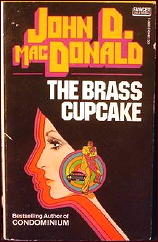
His motives are not so pure, however — there is a fat bonus for him if he manages this. But Bartells is up against more than he bargains for: The dead woman has a lovely niece, someone Bartells can’t look at in a purely professional way; the niece has a boyfriend who is little more than a gigolo; a pair of servants seem to know more about the theft than they claim to the police.
By the time Bartells has sorted through the evidence — as well as his personal feelings on a number of issues — a second murder has occurred, shots have been fired at him, and he knows his future in Florence City is not promising. Unless …
Cliff Bartells is an early version of MacDonald’s later male characters: a complex man who wants to do the right thing and worries about it, because he knows he himself is not incorruptible.
And in the niece, Melody Chance, we see many of the same qualities that appear in later women characters: strength, independence, and straightforwardness, a woman just a trifle weary of life who would like a good man to occasionally lean on.
MacDonald’s depiction of secondary and even incidental characters is also excellent.
———
Reprinted with permission from 1001 Midnights, edited by Bill Pronzini & Marcia Muller and published by The Battered Silicon Dispatch Box, 2007. Copyright © 1986, 2007 by the Pronzini-Muller Family Trust.
Previously on this blog —
April Evil (reviewed by Steve Lewis)
Linda, film and novella (reviewed by Steve Lewis)
Sun 22 Aug 2010
Reviewed by WALKER MARTIN:
MICHELLE NOLAN – Ball Tales: A Study of Baseball, Basketball and Football Fiction of the 1930’s through 1960’s. McFarland, hardcover, February 2010.
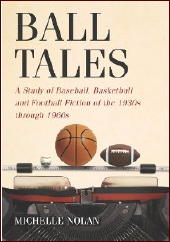
Over the decades I have collected just about every pulp genre except for love pulps and sport pulps. I have several issues of each type, but every time I’d try to read a romance or sports story, the strict formula that these magazines followed would defeat me.
Most of the fiction was very upbeat with happy endings, even more formula-bound than the western pulps. At least I can read the other genres (western, SF, detective, adventure, etc), but not the love and sport pulps.
And this prejudice is not mine alone. I’ve come across a few collectors like Digges La Touche and Steve Lewis who occasionally buy a love pulp, but until I met Michelle Nolan and possibly Randy Vanderbeek, I never really met someone who was seriously collecting runs of sport and love magazines.
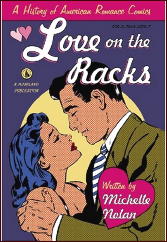
At PulpFest 2010 I had an opportunity to talk to Michelle and we briefly discussed her book, Love on the Racks, which mainly covers the romance comics with a few pages on the love pulps. But the main topic was her new book recently published by McFarland, Ball Tales. Copies are available on amazon.com for $35.00.
If you are at all interested in sports fiction, then you should buy this book. The book mainly discusses sport fiction in books and paperbacks. However pulps are referred to in several chapters, and this is of course of interest to pulp collectors. I counted around 20 cover illustrations of pulps showing a sports scene and many other photos of book covers.
The book is 279 pages long. Pulps are discussed in Chapter One, but the main subject is dime novels. Chapter Two is titled “The Great Pulp Sports Rally During the Depression” and covers sport fiction in many of the pulps like Argosy, Sport Story, and so on.
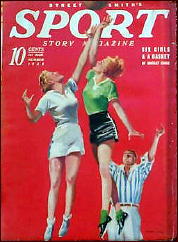
However the best chapter on the pulps (this chapter is a nice long 32 pages) is Chapter Five where Michelle covers sports in many sport and even some love titles. She then covers in Chapter Twelve the only example of female sports competition portrayed on a sports cover (Sport Story, 1st March 1939). This is a very interesting observation when you consider that there were over 1500 sport pulp magazine covers.
She also covers the fact that there have been very few sport pulp anthologies, only three that she lists. Think of it; we live in the Golden Age of Pulp Reprints, but no sport or love reprints from the pulps. (I quickly ordered the three anthologies from abebooks.com).
Finally there is a very valuable appendix: three pages listing the different sport pulp titles, publishers, and years published.
Fellow pulp readers and collectors, this is an excellent piece of original research and if you love sports fiction, or you collect pulps,then it should be in your library.
ADDENDA: Three anthologies taken entirely from the sports pulps are:
Baseball Round-Up, edited by Leo Margulies (Cupples & Leon, 1948).
All American Football Stories, edited by Leo Margulies (Cupples & Leon, 1949).
While the Crowd Cheers, edited by David C. Cooke (E. P. Dutton, 1953)
Michelle also calls The Argosy Book of Sports Stories edited by Rogers Terrill “wonderful,” but these came from the time when Argosy was a men’s adventure magazine, not a pulp. Buy the hardback (A. S. Barnes, 1953) because the paperback (Pennant P-61, 1954) cuts five stories.
Fri 20 Aug 2010
LUKE SHORT – First Claim. Bantam A2057, paperback original; 1st printing, May 1960. Reprinted several times.
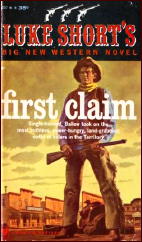
I was disappointed with this one. Short is one of my favorite western authors, but this slender book (only 152 pages) can be read very quickly – not so much because it’s short, but because there’s but a single straight line that can be drawn from the beginning of the story to the end.
When Giff Ballew returns to his home town of Harmony to claim his father’s land that had been confiscated during the Civil War, he finds that it had been taken over by a family of rich ranchers who also own the local lawyer and sheriff, and who aren’t about to give it up now without a fight.
Only the local newspaper editor and publisher is willing to lend him a sympathetic ear, and that doesn’t include the young, good-looking widow who works for him. Her father owes the Weybrights money, and she doesn’t want any trouble aroused by Giff to tumble back on him.
Giff, of course, is stubborn, if not bull-headed, but he’s also in the right. Many of the folks he meets along his way are against him, but he comes also across a growing number who are for him and have not been able to speak up against the Weybrights until now.
The characters are interesting, and they find themselves in very human situations. But for the most part, anyone who’s read a lot of westerns has read this all before. What’s there is tasty enough, but there’s not enough meat in this particular entree to keep you satisfied till breakfast.
Thu 19 Aug 2010
REVIEWED BY BARRY GARDNER:
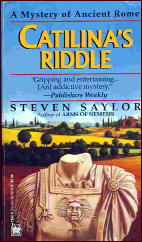
STEVEN SAYLOR – Catilina’s Riddle. St. Martin’s Press, hardcover, October 1993. Reprint paperback: Ivy Books, August 1994. Other reprint editions exist. Roma sub Rosa #3.
I thought the first of this trilogy, Roman Blood, was the best first novel of 1991, and one of the best of that year, period. I have yet to read the second, Arms of Nemesis.
Now Gordianus the Finder (the Roman equivalent of a private eye) is Gordianus the Farmer, having inherited a farm in Etruria from an old friend. He is surrounded by that friend’s relatives, who bitterly contested the will but were defeated in the Roman courts by Gordianus’s old acquaintance and employer, Cicero.
Now Cicero is calling in his marker. He wants Goridianus to allow Catalina, one of Rome’s radical politicians, to occasionally use the farm as a refuge. Not because he’s Catalina’s friend, though; au contraire. He sees this as a way to keep track of his comings and goings. Gordianus reluctantly acquiesces, and thus is drawn into what history was to label the Catiline Conspiracy.
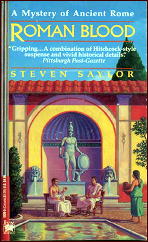
I remain tremendously impressed by Saylor’s skill at interweaving history and fiction and by his ability as a wordsmith. He has created a memorable character and chronicler in Gordianus, whose portrayal has deepened over the course of the series. He has acquired a larger family in the interim between the first and third books, and they too are finely drawn.
As I remarked at the end of the first book, Saylor’s love and knowledge of Roman history is evident on every page – as is his own opinion of the various historical personages.
This is less of a mystery than the first, though there is one, dealing with a series of headless corpses that appear on the farm. Mystery included or mystery aside, though, it’s an excellent novel. I can’t imagine you not liking it.
— Reprinted from Ah, Sweet Mysteries #10, November 1993.
The Roma sub Rosa series —
1. Roman Blood (1990)
2. Arms of Nemesis (1992)
3. Catilina’s Riddle (1993)
4. The Venus Throw (1995)
5. A Murder On the Appian Way (1996)
6. The House of the Vestals (1997)
7. Rubicon (1999)
8. Last Seen in Massilia (2000)
9. A Mist of Prophecies (2002)
10. The Judgement of Caesar (2004)
11. A Gladiator Dies Only Once (2005)
12. The Triumph of Caesar (2008)
Thu 19 Aug 2010
REVIEWED BY WALTER ALBERT:
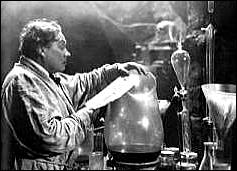
THE MAGICIAN. MGM, 1926. Alice Terry, Paul Wegener, Iván Petrovich, Firmin Gémier, Gladys Hamer, Henry Wilson, Hubert I. Stowitts. Based on the novel by W. Somerset Maugham, adapted by Rex Ingram. Director: Rex Ingram. Shown at Cinecon 27, Hollywood CA, September 1993.
When I told a close friend how excited I was that Cinecon had scheduled one of my long outstanding “must see” films, Ingram’s The Magician, he replied that Ingram was not one of his favorite directors and this film was “one of his weakest.”
Talk about a wet blanket!
He added that the print he had seen was not “a very good one.” Well, I can now report that Cinecon came up with a beautiful print that displayed to marvelous advantage Ingram’s notable pictorial qualities.
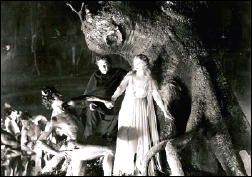
The narrative concerns an Aleister Crowleyish black magician (Paul Wegener, the unforgettable creature of The Golem) who elopes with a beautiful sculptress (played by Alice Terry) whom he needs in a hellish experiment to create life according to a formula he has discovered in an ancient book of sorcery.
The climactic sequences take place in his stone castle, sitting on a hill overlooking an ancient city with cobbled streets and Tenggren-like houses (see the opening sequence of Pinocchio for an artistic equivalent).
He is aided by a malicious, misshapen dwarf, and at the end, the top of the castle blows up. This is the quintessential setting and some of the narrative and character staples of the 1930s Universal Frankenstein cycle, and, if it is hokum (as indeed it is), it is hokum in a style that I can’t resist.
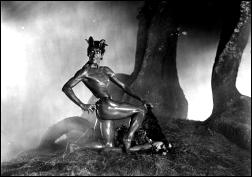
The opening scene is a sculptor’s studio that looks like a plate out of a 19th-century art history book. Wegener’s flamboyant style is perfect for the mesmerizing role of the magician and I am only sorry that there wasn’t a Bride of the Magician, and a Son of the Magician to constitute a cycle.
Now, if somebody will just schedule screenings of Ingram’s Scaramouche and The Four Horsemen of the Apocalypse. But I won’t ask my friend for a recommendation.
Editorial Comment: Dan Stumpf reviewed the book by Maugham this movie is based earlier this year. Check it out on this blog here.
Thu 19 Aug 2010
Posted by Steve under
Reviews[3] Comments
IT IS PURELY MY OPINION
Reviews by L. J. Roberts
DOUGLAS CORLEONE – One Man’s Paradise. St. Martin’s Press, hardcover, April 2010.
Genre: Legal thriller. Leading character: Kevin Corvelli; 1st book. Setting: Hawaii.
First Sentence: They pawed at each other against the black backdrop of night, the restless Pacific waters purring at their feet.
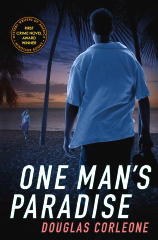
New York Attorney Kevin Corvelli has given up life in the Big Apple. A man he rather carelessly defended and was sentenced for murder, died in prison. He was also innocent.
Corvelli has come to Hawaii thinking he’ll no longer practice criminal law, but only handle misdemeanors. His new landlord has different ideas and Corvelli finds himself defending a young New Jersey man accused of murdering his girlfriend, determined not to have another innocent man go to prison. The killer has different ideas.
This was a bit of a mixed bag for me. Corleone did create a lot of characters. Some were interesting and developed them well while others were not. The voice created for Kevin is one of metaphors, sarcasm and self-deprecating humor, all of which I enjoy: “I let go of the kayak’s leash and the kayak immediately starts to float back to shore. It’s no doubt as frightened of me as I am of it.”
Kevin’s excessive drinking, in spite of the “reasons” for it, and breaking of his own ethical rules made the character unappealing — someone about whom I came to care less the more I read. The emphasis given drinking for both Kevin and his landlord Jake became almost annoying.
For the secondary characters left undeveloped, I was occasionally confused as to who they were. What worked very well was Corleone’s attention to detail. Corleone has an eye for detail and description presenting Hawaii from the eyes of someone newly arrived.
His experience as an attorney is evident. The information on legal process and procedure was interesting without ever seeming analytical. I do love a good courtroom scene, and these were very good.
The story overall was exciting and, at times, very suspenseful. Unfortunately, I did identify the killer early on, in spite of a couple red herrings and very good plot twists. Even so, the ending was very effective.
The book won the Minotaur Books/MWA First Crime Novel Award for 2009. While credible, I always take such accolades with a grain of salt. At the end of the day, it comes down to whether I liked it and would read another book by the author. I thought the book was good, but definitely not great, and would probably read a second book by Mr. Corleone, but he’s not yet going on my “must buy” list.
More law, less alcohol, please.
Rating: Good.
Editorial Comment: An online interview with the author can be found here.
Thu 19 Aug 2010
MIGNON WARNER – Speak No Evil. Doubleday Crime Club, US, hardcover, 1985. Robert Hale, UK, hc, 1986. Hardcover reprint: Detective Book Club, 3-in-1 volume, no date given.
There are some interesting things to be found in Mignon Warner’s mystery bibliography. She was born in Australia but lived primarily in England, and of her eleven books (as of 1994), all take place in the U.K.
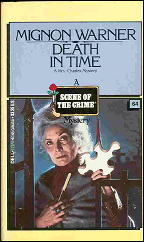
What’s unusual, though, is that several of them appeared in the U.S. before the British edition, and one, Death in Time (1982), was published only in this country. Three early non-series books were published only in England, and are extremely scarce, with (doing a quick search) none presently available on the Internet, at least at the moment. [Update: This is no longer true, but the few copies that are available are pricey.]
Warner’s series character was Mrs. Edwina Charles, a clairvoyant detective who appeared in eight of the eleven, including Death in Time. Speak No Evil, the one in hand, came close to being the last one, but some nine years later another one appeared. Under what circumstances the curiously titled Exit Mr. Punch (1994) finally was published, with no US edition, I cannot say, and I’d like to know.
Hubin, by the way, calls this book a paperback in the Revised Crime Fiction IV, but several copies for sale online are described as having dust jackets, so that’s something we now know that he didn’t (until now).
While I have several of Mrs. Charles earlier adventures, this is the first I’ve read, and besides the actual mystery, she remains also something of a mystery to me. While her given name is actually Adele, she’s revised and adapted her ex-husband’s name, Edwin Charles, for use as her own, even though (on page 26) she considers her marriage to him a very bad mistake. Dating back to the depressing days of “Charles the Third,” she says, there are “names, names of some very important people socially and politically, the publication of which could place them (and her) in very hot water.”
These people may have been clients in those days, but in any case Eddie Charles has an invisible something he’s holding over her. Which brings us to (at last) the case at hand. When is the last time you read a mystery in which a small-time thief (calling himself Jimmy Valentine) hires a private detective (Mrs. Charles) to investigate the strange death (deemed suicide by the authorities) of a another private detective? The latter, also female, is named Tony Manners.
In case you missed the connection, Jimmy Valentine was sent by Mrs. Charless former husband, and she considers having to agree to look into Tony’s death a form of blackmail. It’s a first for me, too.
Also puzzling to me — which is hardly the first time — is — without reading the earlier books in the series — why Mrs. Charles is constantly referred to as a clairvoyante. She doesn’t do anything that even slightly resembles clairvoyeuring until page 163, when a seance is held, which admittedly does help in bringing the case to a close.
Before then, the search for Ms. Manner’s killer, if indeed it was a murder, is a perfectly ordinary one, in a muddled, rambling sort of fashion. Lots of connections between people whose names come up in the investigation, too many coincidences (Mrs. Charles’s very words on page 70), with lots of false trails for the unwary reader to make their down.
Great stuff, I thought, even while I was totally mystified. Or while I was being totally and massively misdirected. Sleight-of-hand such as this is rather uncommon, and if that’s the kind of mystery you enjoy, I think you’ll like this one.
— August 2003 (slightly updated).
The Mrs. Edwina Charles series —
1. A Nice Way to Die. Hale 1976.
2. The Tarot Murders. Hale 1978.
3. Death in Time. Doubleday 1982.
4. The Girl Who Was Clairvoyant. Hale 1983.
5. Devil’s Knell. Hale 1984.
6. Illusion. Hale 1985.
7. Speak No Evil. Hale 1986.
8. Exit Mr. Punch. Breese 1994.
[UPDATE] 08-19-10. I don’t know about you, but I’m intrigued by my own review. I have to confess that I do not remember this book — only that I read it, and in the Detective Book Club edition — but that last paragraph I wrote is a clincher. I’ll have to read it again.
I don’t think either the author or her series character was ever very well-known, and I’m sure both are quite forgotten now.
[UPDATE #2] Later the same day. Here’s some intriguing news from British mystery bookseller Jamie Sturgeon:
Hi Steve,
There are two more Edwina Charles books by Mignon Warner – The Devil’s Hand and The Tarot Reading – both published by Robert Hale in 2008
http://www.halebooks.com/display.asp?K=9780709086215&pge=hale&st2=not+67351&sort=sort_date%2Fd&sf1=Keyword&sf2=lcode&x=20&st1=warner&y=10&m=1&dc=2
Regards,
Jamie
Me again. This is intriguing news. I wonder where these books came from. Is Mignon Warner actively writing again? There are no dates for her in CFIV, so at the moment she’s very much a woman of mystery.
(To see details of the second book, you have to follow the link in the first page of two that the one above sends you to.)
[UPDATE #2] 09-12-10. I’ve postponed saying anything until/unless I had a more definitive answer, but based on an online plot description, Jamie and I now suspect that The Devil’s Hand is a retitled reprint of Devil’s Knell, and therefore it’s a good possibility that The Tarot Reading is the same for The Tarot Murders.
Wed 18 Aug 2010
A 1001 MIDNIGHTS Review
by Susan Dunlap:
LENORE GLEN OFFORD – The Glass Mask. Duell Sloan & Pearce, hardcover, 1944. Paperback reprint: Dell #198, mapback edition, 1947.
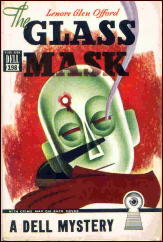
Lenore Glen Offord is one of the truly underrated writers of the World War II and postwar periods. Her characters are engaging and true to their times and environments.
Her heroine, Georgine Wyeth, is the forerunner of today’s feminists — a single mother supporting her daughter with short-term jobs, forcing herself to deal with her fears, to stand up for herself, insisting all the time that she’s tired of being saved.
Most of Offord’s books are set in Berkeley or other areas of northern California. She excels in portraying the uniqueness of the university town and the wartime atmosphere — the paranoia as well as the desperate excitement.
Although she deals more with innocent romantic situations than is stylish now, every seeming digression into a character’s personal life is relevant to the plot.
In The Glass Mask, the chief responsibility for detection shifts from Georgine Wyeth to pulp writer Todd McKinnon, though the story is told from Georgine’s viewpoint. Todd, Georgine, and Georgine’s eight-year-old daughter stop off in a Sacramento Valley town to satisfy his curiosity about a family mystery: Did Gilbert Peabody hasten the death of his ailing grandmother in order to inherit her house and thus be able to afford to marry?
There is no proof, only verdict by rumor. Unable to face the innuendo, Gilbert has enlisted in the army and gone, leaving his wife to deal with the townsfolk and the more unpleasant relatives.
By varying means, she tricks and inveigles the McKinnon-Wyeth menage into staying on day after day to investigate the nocturnal footsteps in the attic, the family patriarch who rants and feigns seizures, and the mystery of what the old lady got from the bank the day she died and where she hid iit.
This is an entertaining tale, and one of Offord’s best. Georgine Wyeth is also at her most appealing in Skeleton Key (1943), in which she investigates the murder of a wartime air-raid warden during an unexpected blackout.
Unfortunately, Offord’s output was not great: merely eight mysteries, four other adult books, and a juvenile. Especially good among the other mysteries are Murder on Russian Hill (1938), The 9 Dark Hours (1941), and The Smiling Tiger (1951).
———
Reprinted with permission from 1001 Midnights, edited by Bill Pronzini & Marcia Muller and published by The Battered Silicon Dispatch Box, 2007. Copyright © 1986, 2007 by the Pronzini-Muller Family Trust.
Editorial Comment: Some additional bio-bibliographical information on Lenore Glen Offord follows the review preceding this one, that of The Smiling Tiger, written by Bill Deeck.
« Previous Page — Next Page »


